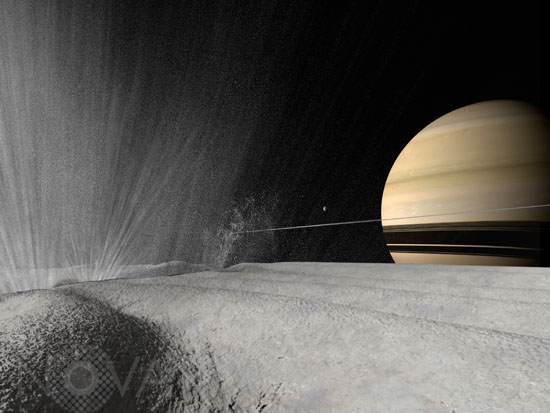Photo Agency - Astronomy - Space - Nature

Water geyser on Enceladus - Artist view
author: Walter B. Myers/Novapix
reference: a-sat99-00210
Image Size 300 DPI: 33 * 25 cm
Liquid water reaches the surface of Enceladus' south pole and drives a massive plume of ice crystals into the sky. The combination of Enceladus' low surface gravity and the geyser's force accelerate the crystals to escape velocity, where sunlight breaks the water molecules down into their constituent atoms of hydrogen and oxygen. Saturn itself appears low on the horizon due to the proximity to Enceladus' pole.
The small object immediately to Saturn's left is another icy moon named Mimas. Somewhat smaller than Enceladus and closer to Saturn, Mimas sprints around Saturn in slightly less than one Earth day.
In March 2006 NASA's Cassini probe revealed evidence of water-driven geysers on the surface of Enceladus. At first glance Enceladus doesn't seem to be a likely host for liquid water as the surface is extremely cold, about -330° F. However, tidal forces from Saturn's massive gravity alternately pull and push on Enceladus' interior, creating enough heat to melt the water ice immediately beneath the surface. This water is believed to periodically break through the surface as geysers, similar to Yellowstone's Old Faithful.
There are only three other places in the Solar System where this kind of geologic activity is known to exist: our own Earth, Jupiter's satellite Io, and Neptune's satellite Triton. What makes Enceladus especially interesting is that this the most compelling evidence yet for liquid water--a requirement for life--on any world beyond the Earth.
Keywords for this photo:
ASTRONOMY - E RING - ENCELADUS - ERUPTION - GEYSER - ICE - ILLUSTRATION - MIMAS - PLANET - RING - SATELLITE - SATURN - SATURN'S MOON -
Contact : Stéphane Aubin +33-(0)9-51-26-53-76
© Novapix - All rights reserved


